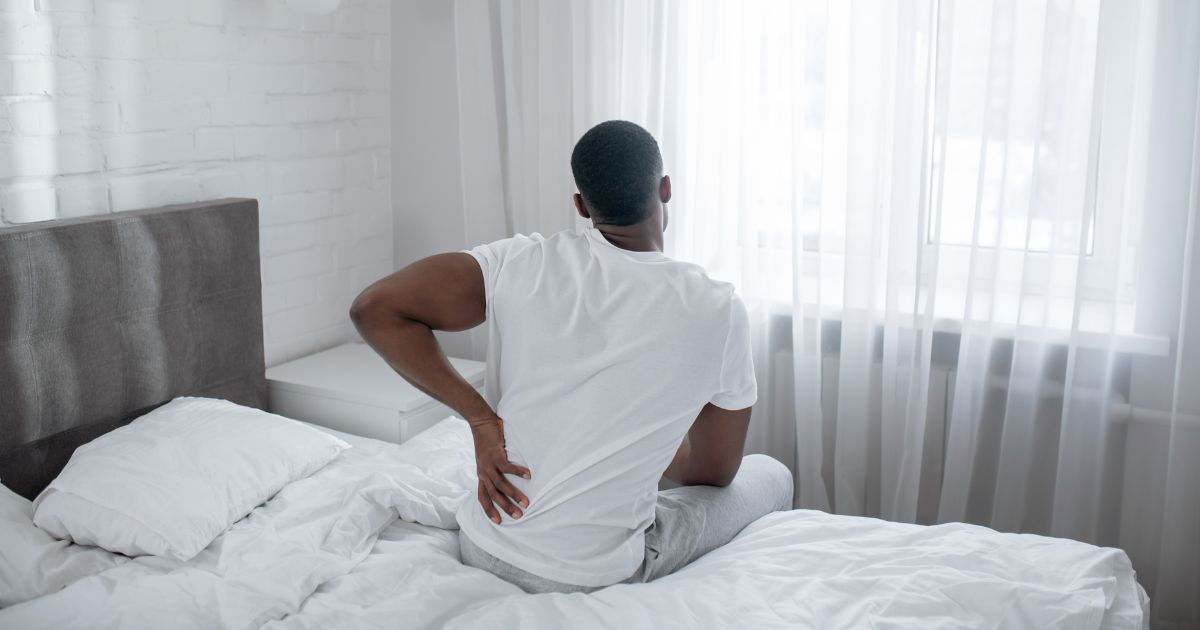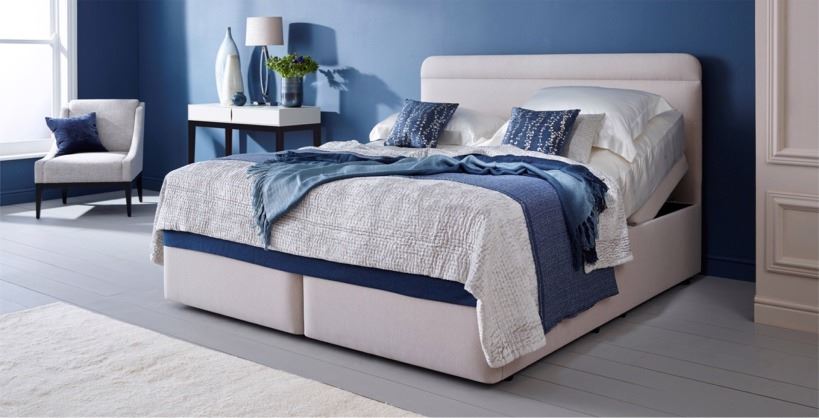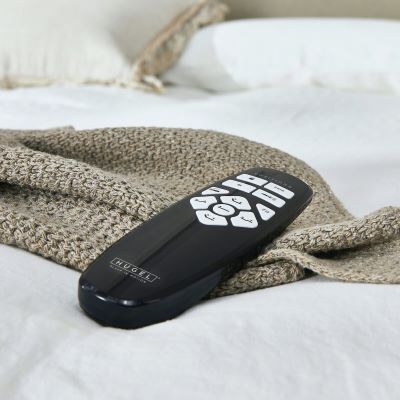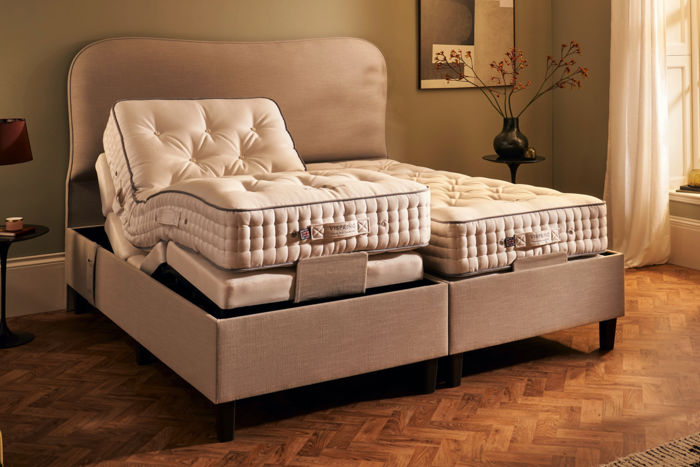Adjustable Beds for Back Pain

Why back pain affects sleep
Back pain is one of the most common complaints we hear from customers. Whether it’s a dull ache in the lower back or stiffness that sets in overnight, it can have a real impact on how well you sleep and how rested you feel in the morning.
For many people, the problem isn’t just the pain itself; it’s how we sleep. A flat mattress can sometimes force the body into an unnatural position, putting pressure on joints, muscles and nerves, and often making the problem worse.
That’s where an adjustable bed can help. By giving you the ability to raise or lower the head and foot of the bed, you can find a position that eases pressure and supports your body more naturally – especially the lower back, where most people feel discomfort.
In this guide, we’ll explain how adjustable beds can support back health, who they’re best suited for, and what to look for if you’re considering one for yourself.
How adjustable beds support the back
Improving your sleep posture is one of the most effective ways to manage back pain at night, and that’s exactly what an adjustable bed allows you to do.
When we lie flat on a traditional mattress, gravity and body weight can put strain on the lower back, especially if the spine isn’t well supported. For some people, this leads to tension in the muscles around the lumbar area; for others, it can aggravate existing conditions like sciatica or herniated discs.
An adjustable bed helps by letting you change your position at the touch of a button. This means you can:
- Raise the upper body slightly to reduce pressure on the lower spine and improve breathing.
- Lift the legs to take weight off the lower back and ease tension in the hips and pelvis.
- Find the right angle for your unique body shape and condition, rather than being forced to sleep flat.
Even small adjustments can make a big difference. And because the position is supported by the bed itself (rather than propped up with pillows), it stays consistent and comfortable throughout the night.

Who might benefit most?
While adjustable beds can be helpful for almost anyone, they’re particularly beneficial for people dealing with chronic back pain or musculoskeletal conditions that make sleep difficult.
You might see the greatest improvement in these situations:
Lower back pain
Whether it’s caused by poor posture, muscle strain, or long-term wear and tear, lower back pain is one of the most common reasons people turn to adjustable beds. Elevating the knees slightly helps take the pressure off the lumbar spine, allowing muscles to relax and inflammation to ease.
Sciatica and nerve-related pain
Sciatica, which often causes sharp pain radiating down the leg, is typically caused by compression of the sciatic nerve. An adjustable bed allows you to reduce strain on the lower spine and hips, which helps relieve nerve pressure and ease discomfort.
Arthritis or spinal conditions
Conditions like osteoarthritis, spinal stenosis, or degenerative disc disease can make it hard to get comfortable in a flat bed. Being able to find a supported, elevated position can reduce stiffness and morning pain, especially around the hips and lower back.
Injury recovery and post-surgical support
For those recovering from back surgery, sports injuries, or general mobility issues, adjustable beds can make getting in and out of bed easier and more comfortable.
Recommended sleeping positions for back pain
When it comes to managing back pain, how you sleep can be just as important as where. Here are a few of the most helpful sleeping positions we recommend to our customers:
- The zero-gravity position - Inspired by NASA, this popular position raises both the head and the legs slightly, creating a gentle “V” shape. It takes pressure off the lower back and promotes better blood flow, ideal for those with lumbar pain or poor circulation.
- Slight leg elevation - Raising the legs just a few inches can help relieve tension in the lower back, especially if you tend to sleep on your back. This simple change can ease pressure on the spine and help tight muscles relax overnight.
- Back or side-sleeping with support - Adjustable beds are particularly helpful for back sleepers who need extra lumbar support. Side sleepers can also benefit by slightly raising the upper body and knees, which can improve spinal alignment and reduce pressure on the hips and shoulders.
Your adjustable bed will allow you to fine-tune the angle of each position to suit your body, your condition, and even how you feel on a given night, something a regular bed simply can’t offer.
Other features to look for
When choosing an adjustable bed, the base itself is just part of the equation. The right features can make a big difference in both comfort and day-to-day usability, especially if you’re dealing with the discomfort of back pain.
Here are some extras worth considering:
- Memory Presets: This allows you to save your favourite positions, so you can return to them at the touch of a button. This is especially handy if you find a particular angle that eases your back pain – no need to re-adjust every night.
- Massage Functions: Some models come with built-in massage settings designed to relax the muscles and stimulate circulation. While not essential, many people with back pain find this feature soothing, especially at bedtime.
- Mattress Compatibility: Not all mattresses work well on an adjustable base. You’ll want one that’s supportive but flexible, such as memory foam, latex, or hybrid designs. Some high-quality pocket sprung mattresses can also be suitable but check the construction carefully (we’re happy to advise).
- Ease of Use and Remote Control: Look for a bed with a simple handset – or an app if you prefer smart controls. If you live with limited mobility or arthritis, large buttons and backlit remotes can be a big help.
- Added Touches: Features like under-bed lighting, USB charging ports or wall-hugging designs (which keep you closer to your bedside table when the bed moves) can improve safety and convenience, especially during the night.
Not sure if the extras are worth paying for? We’ll always give honest advice based on what matters most to you – whether that’s pain relief, independence, or everyday comfort.

Explore adjustable beds recommended for back pain
Finding the right adjustable bed is about choosing a model that truly supports your body and helps you sleep better, night after night. We’ve hand-picked a range of beds that are particularly well-suited to people living with back pain, based on years of experience helping customers find the right fit.
Adjustable beds
Browse our selection of adjustable beds with lumbar-friendly positioning, smooth motors, and easy-to-use controls, ideal for anyone needing day-to-day relief from lower back pain.
Shop adjustable beds for back pain.
Compatible mattresses
The right mattress is just as important. We recommend flexible, supportive options that contour to your body without sagging: including memory foam, latex, and carefully chosen pocket-sprung designs.
View mattresses for adjustable beds.
Customise your set-up
Not sure what combination’s right for you? We’ll help you match the right base with the best mattress, tailoring the setup to your needs. We also work with suppliers who can manufacture bespoke sizes and provide solutions for your needs.
FAQs
- Can an adjustable bed cure my back pain?
Not exactly. It won’t fix the underlying cause, so you should consult your doctor about that. But the right position can make a big difference to how much pain you feel at night and how rested you are in the morning. Many customers report better sleep and less stiffness thanks to improved support and posture. - Is it better to sleep on your back or side if you have back pain?
It depends on the type of pain you’re dealing with. Back sleepers often benefit from slight leg elevation, while side sleepers may feel better with a raised upper body and knees supported. An adjustable bed lets you experiment and find what works best for you. - Do adjustable beds cause back pain?
It’s unlikely, but it can happen if the bed isn’t set up properly or the mattress doesn’t offer the right support. Sleeping at too steep an angle, or with poor spinal alignment, can lead to new aches or make existing pain worse over time. The key is to adjust the bed gradually, find a position that feels natural, and pair it with a suitable mattress. Most people find relief with small changes like raising the knees or gently inclining the upper body. If in doubt, we’re always happy to help you find a position and set-up that works for you. - Do doctors recommend adjustable beds for back pain?
Many healthcare professionals do recommend adjustable beds for managing back pain, but it depends on your individual condition and whether elevated positions offer relief. A qualified spine specialist or physical therapist can best advise if an adjustable set-up aligns with your needs. Remember, an adjustable bed isn’t a cure-all, but it can be an important part of your pain-management plan.
Try before you buy
Buying an adjustable bed is a big decision, especially if you’re living with back pain. That’s why we always recommend trying a few in person, if you can.
At The Bed Specialist, we offer:
- In-store guidance – Friendly, experienced advice; no pressure, no jargon.
- Free, expert delivery and set-up – Adjustable beds are big and often heavy. We’ll deliver your adjustable bed free of charge, install it and make sure everything’s working just as it should.
- Ongoing support – Questions after delivery? Our job doesn’t stop once the bed arrives. We’re always here to help.
Not sure where to begin? A quick chat with our team could point you in the right direction, and save you hours of guesswork.
Category: Adjustable Beds
Similar Posts
Adjustable Beds for Acid Reflux
In this guide, we talk about how an adjustable bed can help reduce symptoms of acid reflux and improve the quality of your sleep.
5 min read
Adjustable Beds & Mattresses: Benefits, Uses & Choosing the Right One
In this guide, we’ll explain who adjustable beds and mattresses are for, how they help, and what to look for when choosing the right one.
8 min read











